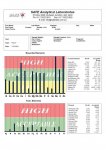
Hi Taniaaust1,
Thank you very much for the positive words. It can be good to be your own advocate. I learned this the hard way when my health was severely compromised by a medical professional that had no knowledge of nutrition! I wish I had researched his advice.
In my opinion your high copper does not mean you have too much copper, it means you are not making enough of its carrier protein and/or binding it to the protein, thus you have circulating levels of unbound (free radical) copper in your bloodstream, which is observed in your hair. (Henna does not affect the hair test results) Normally, when I see copper elevated above the normal range it either means the person participates in aerobic exercise regularly and/or they eat a diet of high copper foods such as chocolate, potatoes, oysters, nuts, sunflower/pumpkin/squash seeds, tomatoes, lobster/calamari, legumes, dried herbs especially basil, marjoram, parsley and oregano. The high reading just accentuates that the body is having trouble binding copper in the liver.
Molybdenum is a strong chelator of copper (removes from the body). Cattle can actually have copper deficiency when they graze on pasture grass that is high in molybdenum. Molybdenum also chelates calcium. Your chart indicates high calcium, meaning loss from the body and into the hair instead of being deposited into the bones. High calcium slows the energy producing system. Inadequate amounts of bound copper can lead to osteoporosis and joint pain because it is necessary to place your calcium into your bones with the help of magnesium and vitamin D. I believe you became low in molybdenum because it has been attempting to remove your excess, unbound copper. So by taking molybdenum you can continue to remove the free radical copper and lower the calcium and it makes you feel better. But in time, you may not have enough calcium to keep your bones strong and not enough copper to keep excess iron from over accumulating in your liver and body tissues. Best to address what is causing the unbound copper and loss of calcium in the first place but apparently when you received your hair test results, you did not have anyone to help you understand the chart based on nutritional factors.
I have worked with many Bedlington Terriers. They are known as dogs that accumulate high levels of copper in their livers. Hair charts were preformed on these dogs before and after use of chealtors for copper. Molybdenum as well as penicillamine was tested. Prior to chelation, the hair tests have always shown elevated copper (just as your hair chart indicated) and many times elevated iron. After chelation, liver biopsies indicated stores of copper and iron were lowered. The retest charts showed very low copper, iron, manganese and calcium, but the charts still did not indicate adequate binding of copper, iron and/or manganese. So the question that presented itself was why were they re-accumulating copper and iron in the liver once off of the chelator and circulating unbound copper and iron again, as seen elevating on the hair charts. Another question was why are liver biopsies indicating elevation of copper in every breed of dog that is tested, not just Bedlington Terriers? And last, why did some dogs that were biopsied with very high levels of copper, exhibit no adverse symptoms. The answer that I sought appeared to have a commonality between human and dogs since the charts were uncannily similar. So I searched for what would both be exposed to which could create such a similar imbalance.
In the photos above and below, you can see two dog tails. I call this the tale of the tails. The color change from dark brown to orange indicates inability of the body to adequately bind copper and iron, with which the body uses to color the fur. Bound copper allows the body to use iron. Copper gives a Vizsla dog its orange color. Combination of copper, iron and manganese give various shades of brown coloration. Iron and manganese create black. As the dogs ability to bind copper lowers, which lowers their ability to adequately bind and place iron into the fur, you see the color lightens revealing the higher copper with less iron and manganese. My experience indicates extremities of the body normally show the imbalance first, because the body allocates minerals to life critical processes first and coloring the tail is not a life critical function.
Two important questions: I believe your wheat products are enriched in Australia with iron, niacin, folic acid, etc. Is this true?
Is your milk enriched with vitamins A & D?







